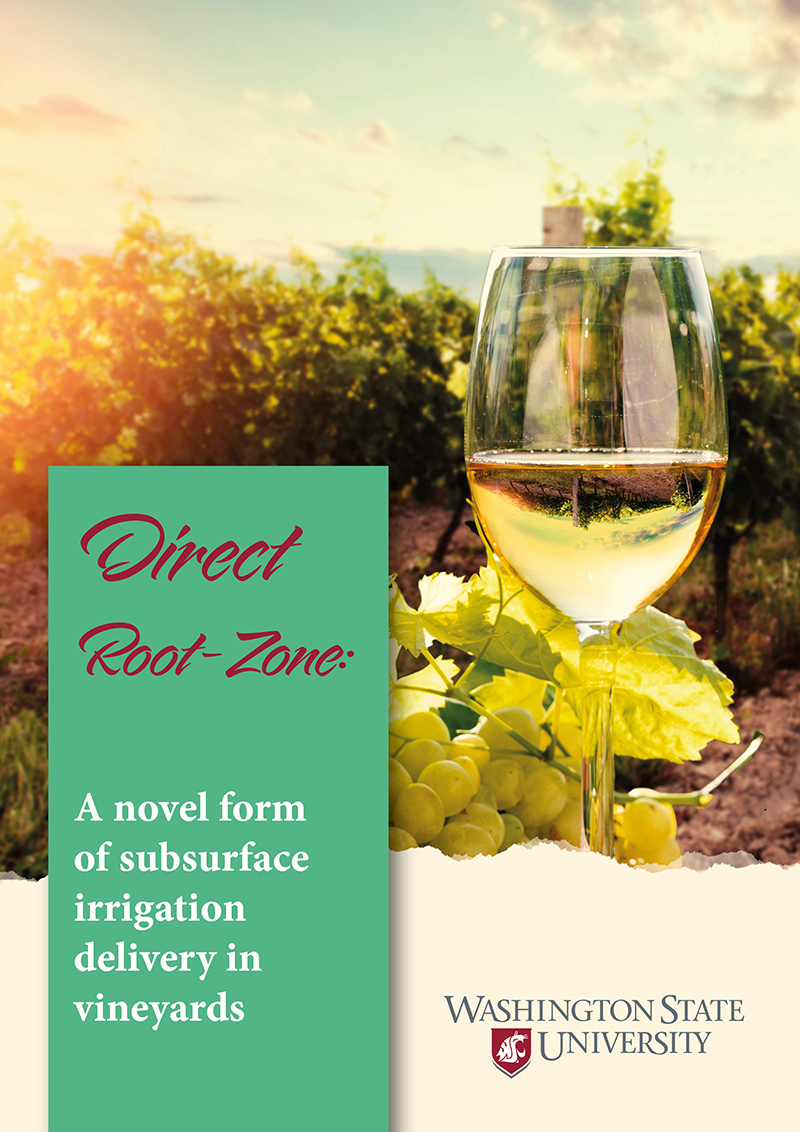In this eBook, we hear from Pete W. Jacoby from the Department of Crop and Soil Sciences at Washington State University, where he explores how direct root-zone subsurface drip irrigation can enhance vineyard resilience to drought
A decade of applied research performed in commercial vineyards within the Columbia Basin of Washington State has demonstrated the potential use of a novel form of drip irrigation to save water while maintaining desired yields and quality of winegrapes. Delivering drip irrigation via plastic tubes to subsurface depths of 30-90 cm saved up to 35 per cent of water applied by surface drip methods.
No significant differences in vine activity or production among the three depths of water delivery applied by direct root-zone (DRZ) were determined, leading to a recommendation of releasing water at 45-60 cm depth in subsequent studies (Figure 1).
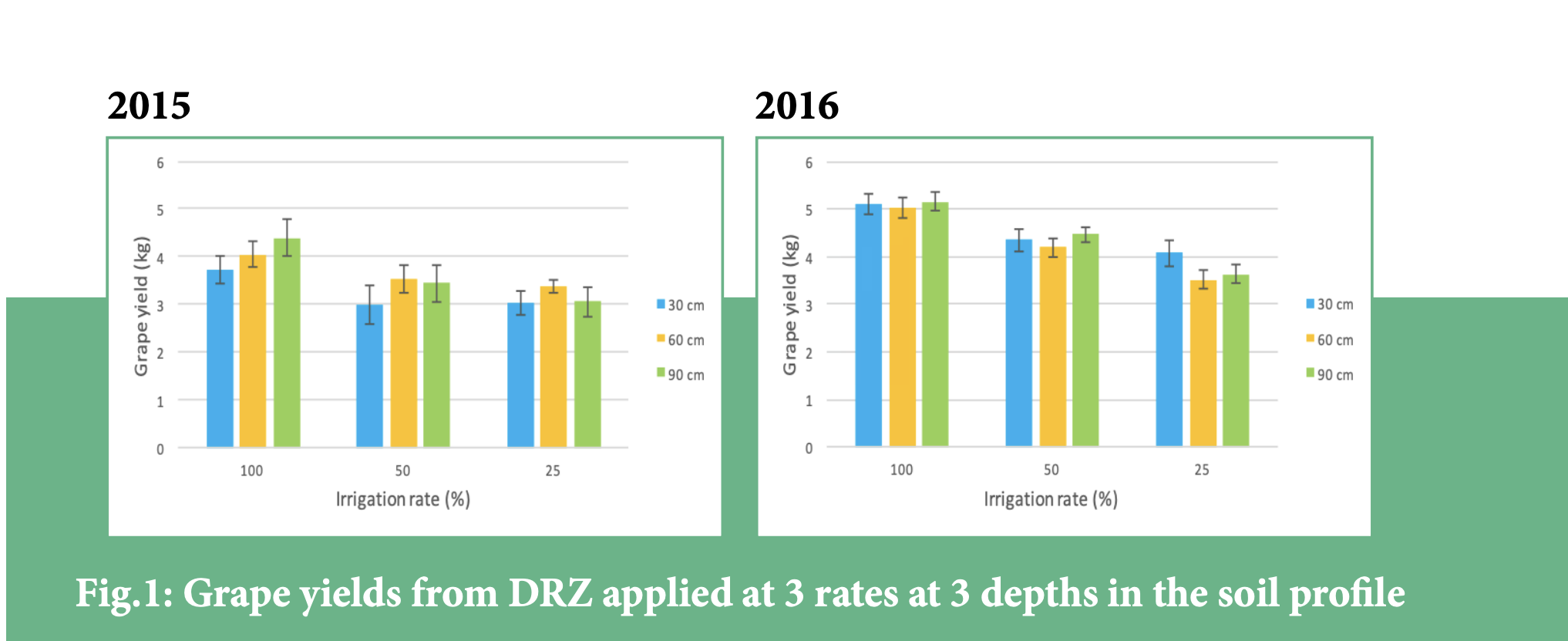
Ensuring winegrape production throughout droughts
In regions of the world where winegrape production is a major agricultural commodity, growers are facing challenges to sustain the health and productivity of perennial crops under hotter and drier climatic conditions, often referenced as “drought”. Even where irrigation is used to supplement natural rainfall, improved application methods and viticultural practices are being developed and implemented to maintain the profitable production of crops.
The use of surface drip irrigation has emerged as the most efficient and effective means for applying supplemental water needed during the drier periods of the production season, especially in regions having a Mediterranean climate pattern, typified by having cool wet winters and hot, dry summers.
Water applied by drip irrigation to the soil surface is subject to evaporation and use by non-crop plants, often referenced as “weeds”. Applying irrigation through buried driplines has been shown to increase crop water efficiency; however, subsurface driplines are subject to soil clogging or damage by burrowing rodents in certain regions.
DRZ delivery involves the vertical placement of a polyvinyl tube near the base of the vine into which a small diameter tube is inserted to allow the water to be released into the soil at a depth of 45-60 cm below the soil surface.
The lower end of the tube may be fitted with a cover of fiberglass clothe to thwart the intrusion of soil and roots into the tube. A vinyl top cap may be used as an indicator of tube blockage when water pressure within the tube removes it. Direct root-zone delivery tubes can be installed at the time of planting young vines or may require drilling an access hole near the base of an established vine for tube insertion (Figure 2).
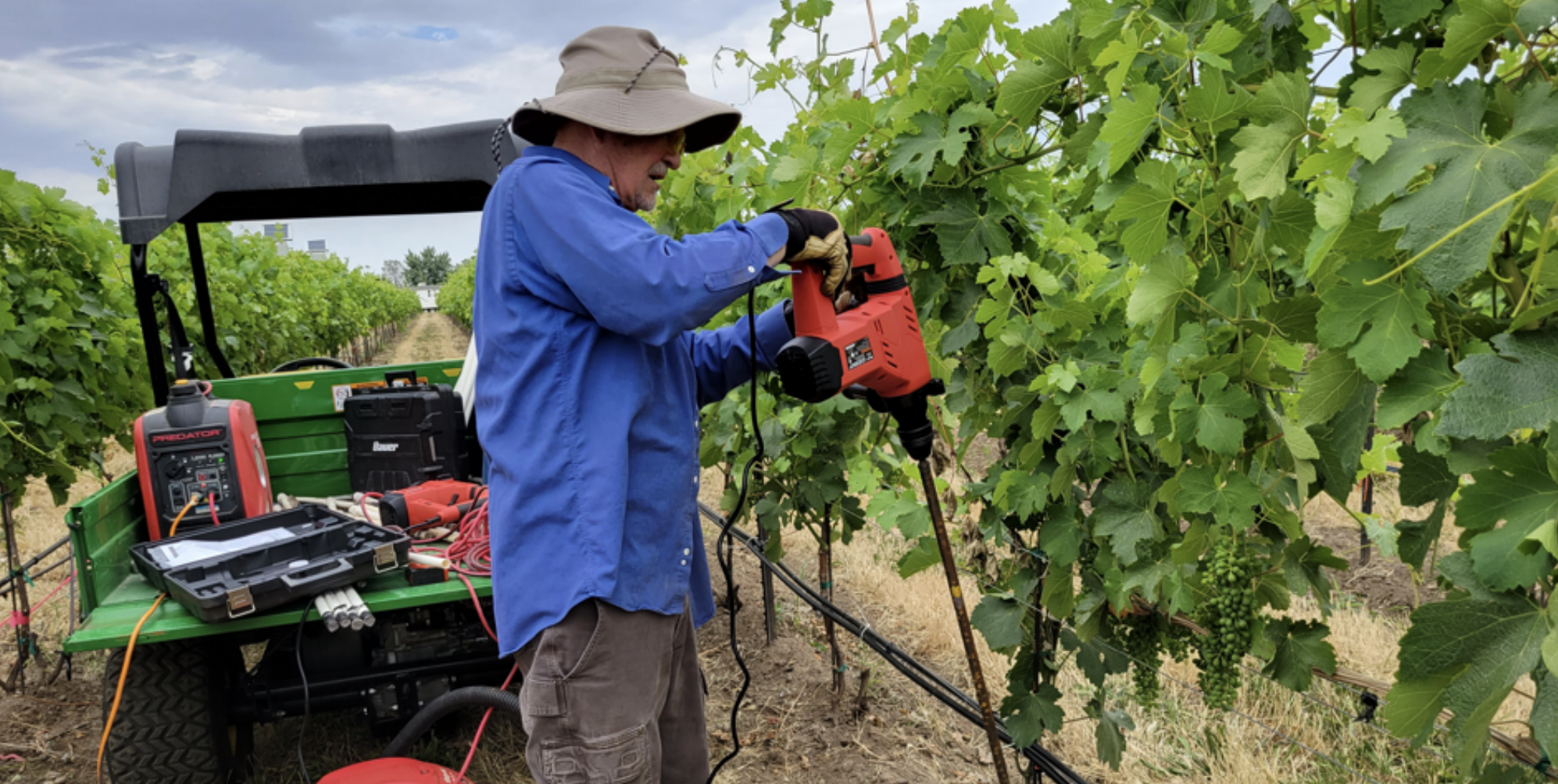
Assessing soil water content, movement, and use with sensors
Understanding the dynamics of water movement within a soil requires an appreciation of the numerous factors that influence water movement within the soil. Gravity obviously plays a role in the downward movement of water, but other factors, such as the ability of soils to use ionic conductivity, which exist within the individual soil particles to attract or repel water molecules, also play a role in transporting water in all directions according to the type of soil involves.
Roots also play a role in the movement and transport of water within the soil, and for a number of desert plants, this phenomenon labelled “hydraulic redistribution”, is considered to be an important survival mechanism.
Root biomass and distribution within soil is heavily influenced by the location, amount, and frequency of irrigation or natural precipitation. In the typical vineyard receiving surface drip irrigation, the bulk of root biomass resides in the upper 30-40 cm of the soil profile. However, under DRZ subsurface irrigation, roots were found to change their locational architecture in response to water being delivered to the deeper part of the soil profile.
In theory, vines with deeper root systems should have more resilience to drought by being able to access water that is less impacted by the drying impacts from higher temperatures in the uppermost layers of the soil. Commercial winegrape production often involves the use of “deficit irrigation” to enhance the quality of winegrapes for subsequent making of premium quality wines.
This process involves reducing irrigation to replace less water than the vine is expending through its physiological development. This natural water loss is referenced as “evapotranspiration” or ET. By supplying less water than used, the vine will experience some water stress which has been associated with increases in compounds such as sugars, tannins, and, in red-skinned grapes, anthocyanins.
These and other factors, such as acidity and alcohol content, can impact wine quality. Deficit irrigation works best when the vine is totally dependent on supplement irrigation after the grape begins to attain full size and begins coloration towards maturity. This stage of grape development is defined by the term “veraison”.
Comparisons between surface and subsurface drip irrigation delivery methods
Electron capacitance probes with sensors placed at 8 depths incrementally from 18 -183 cm were used to track water dynamics within the vertical soil profile of a commercial vineyard in southcentral Washington State. Selected rows of vines were irrigated with either surface drip (SD) or subsurface drip (DRZ) irrigation over several growing seasons. Four rates of each irrigation delivery method were used to represent irrigation levels (100, 80, 60, and 40% of ET water loss replacement). Irrigation events were repeated every four days during the primary growing season (from fruit set through harvest).
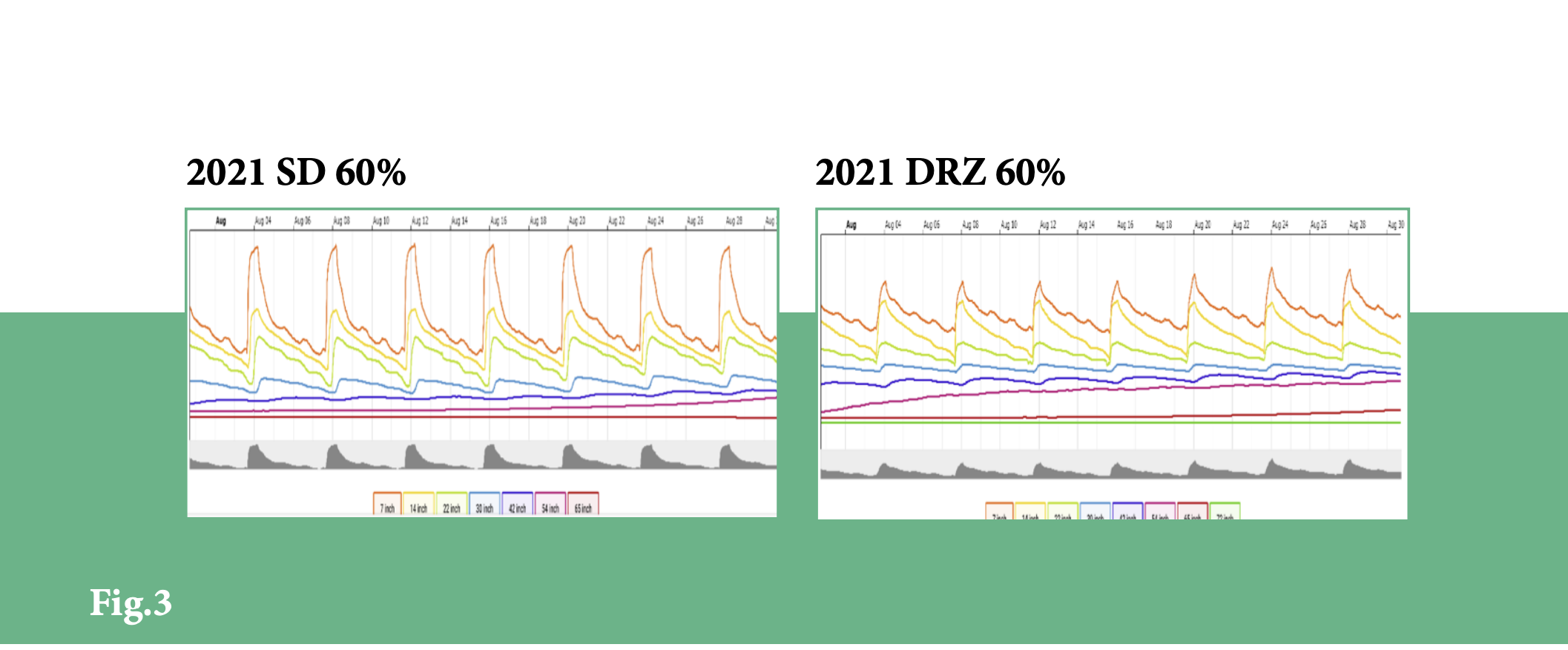
Figure 3 compares the relative soil water content occurring for each depth of the soil profile between repeated irrigation events during a portion of the 2021 summer growing season for the 60% level of full water replacement. Surface drip irrigation (left) illustrates soil water saturation within the top portion of the soil profile (orange) displayed by the somewhat flattened peak at the end of each irrigation event followed by a period of rapid water loss.
There is a time delay in the peaks of maximum water at each lower level of the soil profile, with soil water content becoming more stable at the 76 cm depth (light blue). A slight increase in soil water content occurs at the 107 cm depth (dark blue), while soil moisture in the three levels below remains unchanged, indicating no evidence of water extraction by roots.
In contrast, under direct root-zone (right), water is released into the soil at the 60 cm depth (green) and moves via soil capillary and root action to peak slightly in the portion of the soil profile above or below the point of release. Variation in soil water content between repeated irrigation events is much lower under DRZ delivery than under SD. Overall loss or use of soil water is consistent among all depths of the soil profile, with an indication of an overall increase in soil water content between the 76 cm depth and the 183 cm depth.
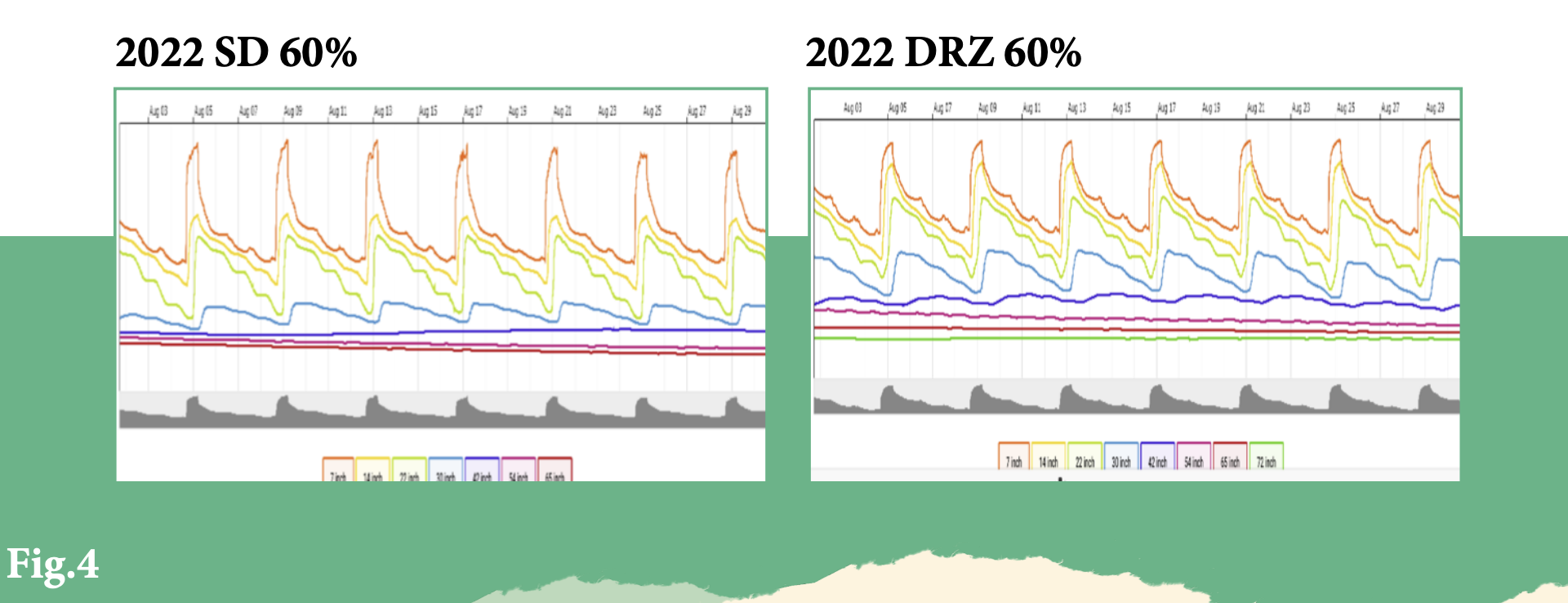
The 2022 growing season was hotter than 2021 and average daily temperatures were 3oC higher in August. In Figure 4, data from August 2022 are displayed for soil water content. The chart for SD delivery (left) shows similar patterns of water content as during 2021 except for having less increase in soil water content below the 76 cm depth. Both of the 2022 charts illustrate a steeper decline of soil water than in 2021 and also show a more pronounced diurnal pattern that is associated with increased water use by the vine.
Under DRZ delivery (right), more variation between irrigation events is shown in the upper 4 depths in 2022, suggesting a higher water demand by the vine during a hotter growing season than the previous year. Overall soil water content below the 107 cm depth is shown to decrease during August 2022 in contrast to remaining constant during 2021, which also suggests greater water demands during a hotter year.
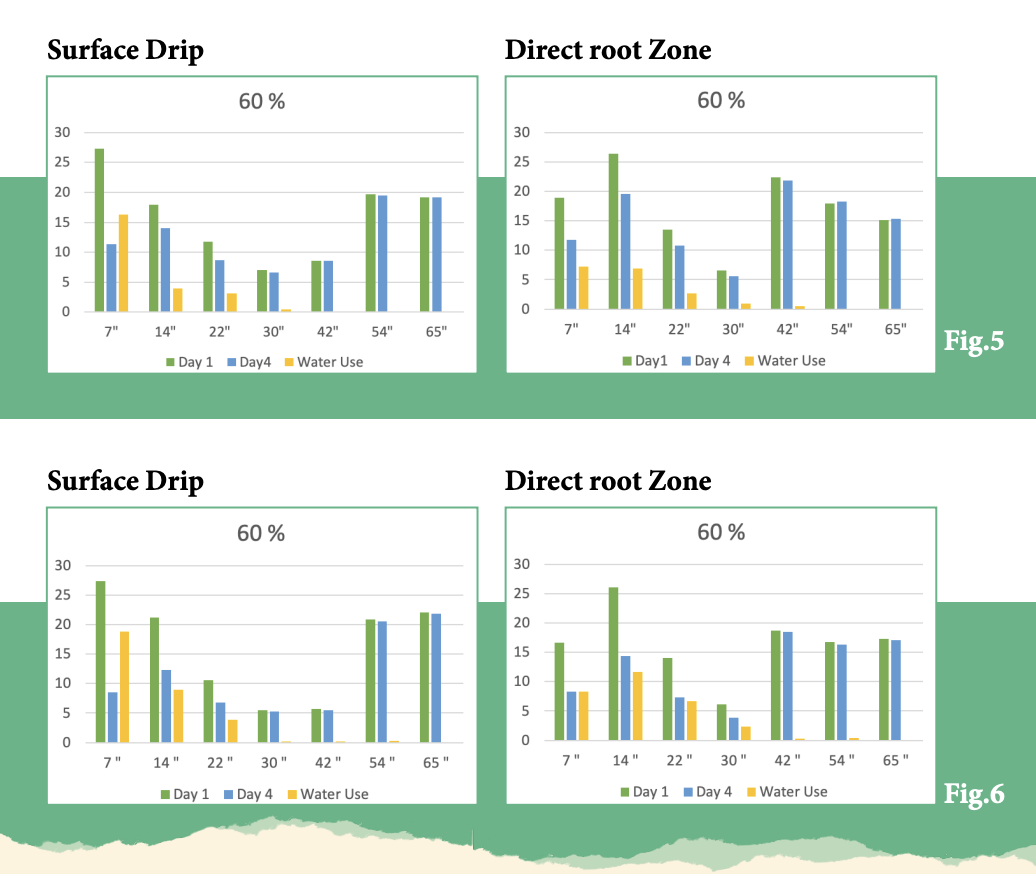
Figures 5 and 6 summarize the data shown in the previous figures as bar graphs. The yellow bars represent the difference between the highest and lowest measures of soil water content averaged over the month of August. This bar also provides a measure of relative water use by depth under each method of delivery (SD vs. DRZ).
Providing growers with the opportunity to save water during a drought
Subsurface drip irrigation applied via direct root-zone delivery provides an option for growers to save water and achieve crop production of winegrapes during drought conditions. When coupled with soil water content sensors, irrigation can be scheduled more precisely to thwart potential impacts on vine health and productivity before they occur. Additional data will be collected over the next several years to correlate water dynamics under varying levels of summer growing conditions and to assess the use of DRZ subsurface drip irrigation to ameliorate impacts on vine performance during drought conditions.

